Trying to refresh your bookshelves without spending a cent? You really don’t need to buy new décor to get those designer-worthy displays. Beautiful bookshelf styling is totally possible with items you already have scattered around the house. You’ll save some cash and give your shelves a whole new vibe.
Remember to repin your favorite images!
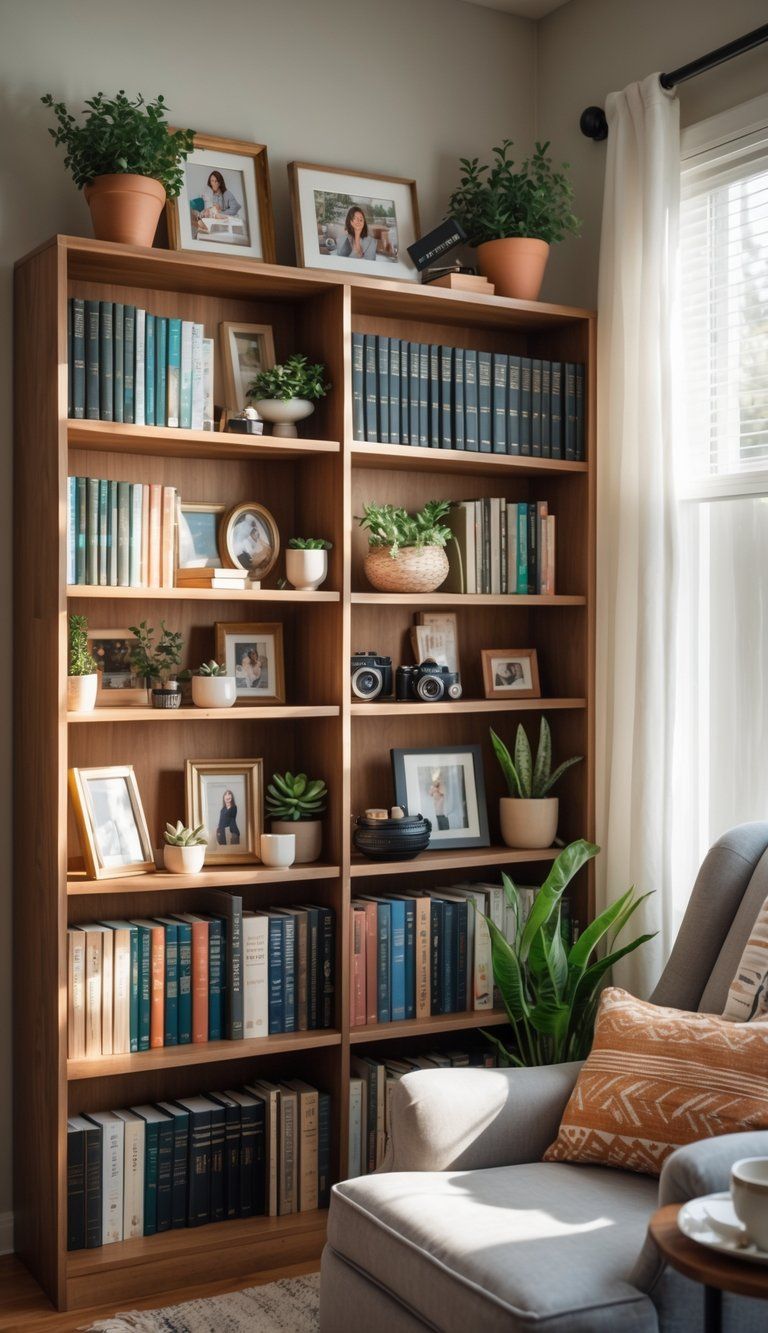
Start by grabbing things from every room—books, picture frames, little pieces of art, vases, and decorative objects that share a color or vibe. This little scavenger hunt often uncovers forgotten treasures that perk up your shelves. You might be surprised by what you already own.
It’s all about how you arrange things, not how much you buy. Try lining up your books by color, stacking some horizontally, or placing bigger items first and filling in the rest around them. These tweaks can turn your shelves into a display that feels both professional and totally personal.
Understanding The Basics Of Bookshelf Styling
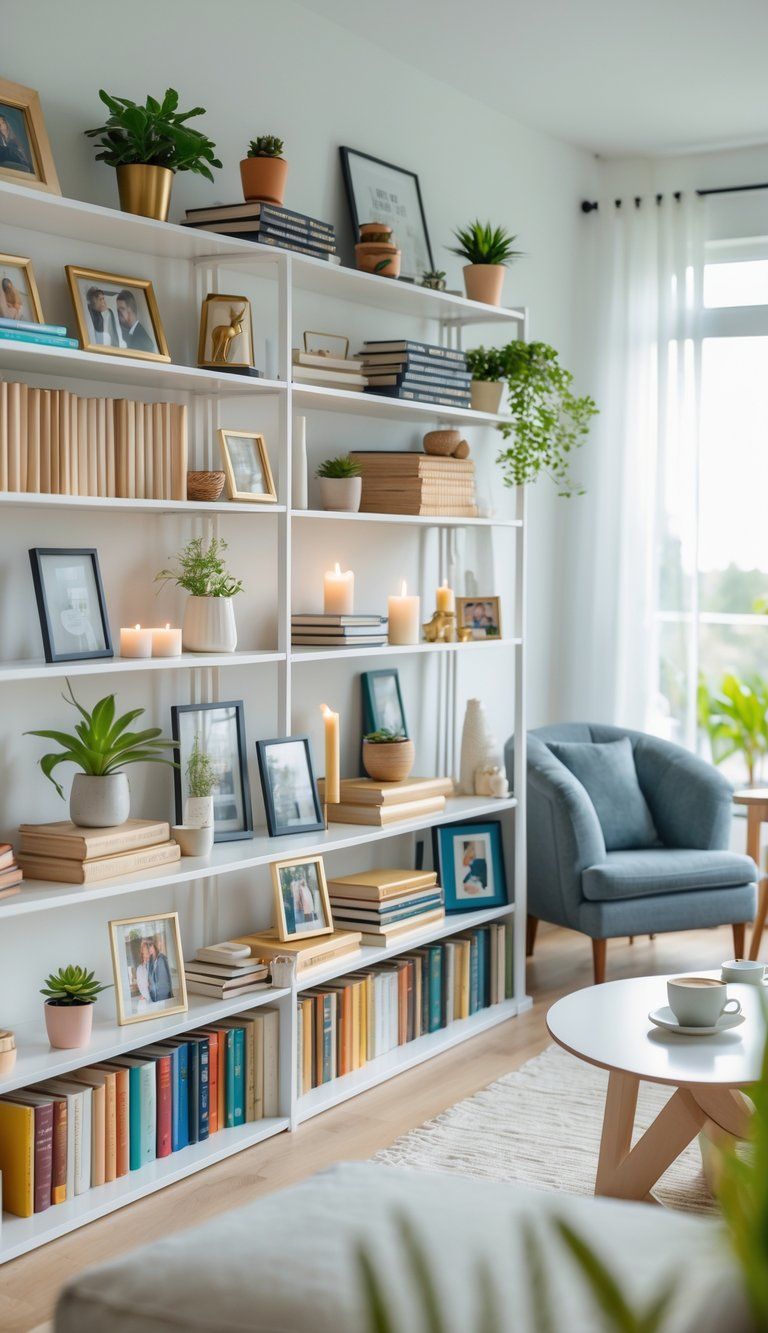
Turning your bookshelves from cluttered storage into stylish displays starts with a few key ideas. Good bookshelf styling balances usefulness and beauty, so your shelves hold your stuff and look intentional.
The Importance Of Visual Interest
Visual interest is what makes your shelves pop instead of blending in. Mix up the heights, shapes, and sizes of things you put on display. Try this:
- Stack some books vertically, others horizontally to change up the look
- Add tall and short objects like vases, plants, or frames
- Pick at least one unique “conversation piece” for each shelf
Leave some empty spots. Don’t cram every inch. Letting your shelves breathe makes your favorite pieces stand out. This trick, called negative space, keeps things from looking too busy.
Put heavier or larger items at the bottom. That grounds your display and keeps everything feeling balanced.
Defining A Cohesive Look
A cohesive look means your shelves tell one story, not a dozen. Pick a color scheme that fits your room. You don’t need to color-code every book, but you can:
- Put books with similar colored spines together
- Turn some books around for a neutral, textured look
- Use jackets that match your palette
Let your personal style shine through. If you love vintage finds, show off old cameras or antique bookends. Prefer modern? Go for sleek shapes and clean lines.
The real magic comes from using what you already have. Family photos, travel souvenirs, and special collections make your shelves feel like you—not just a catalog.
Assessing What You Already Own
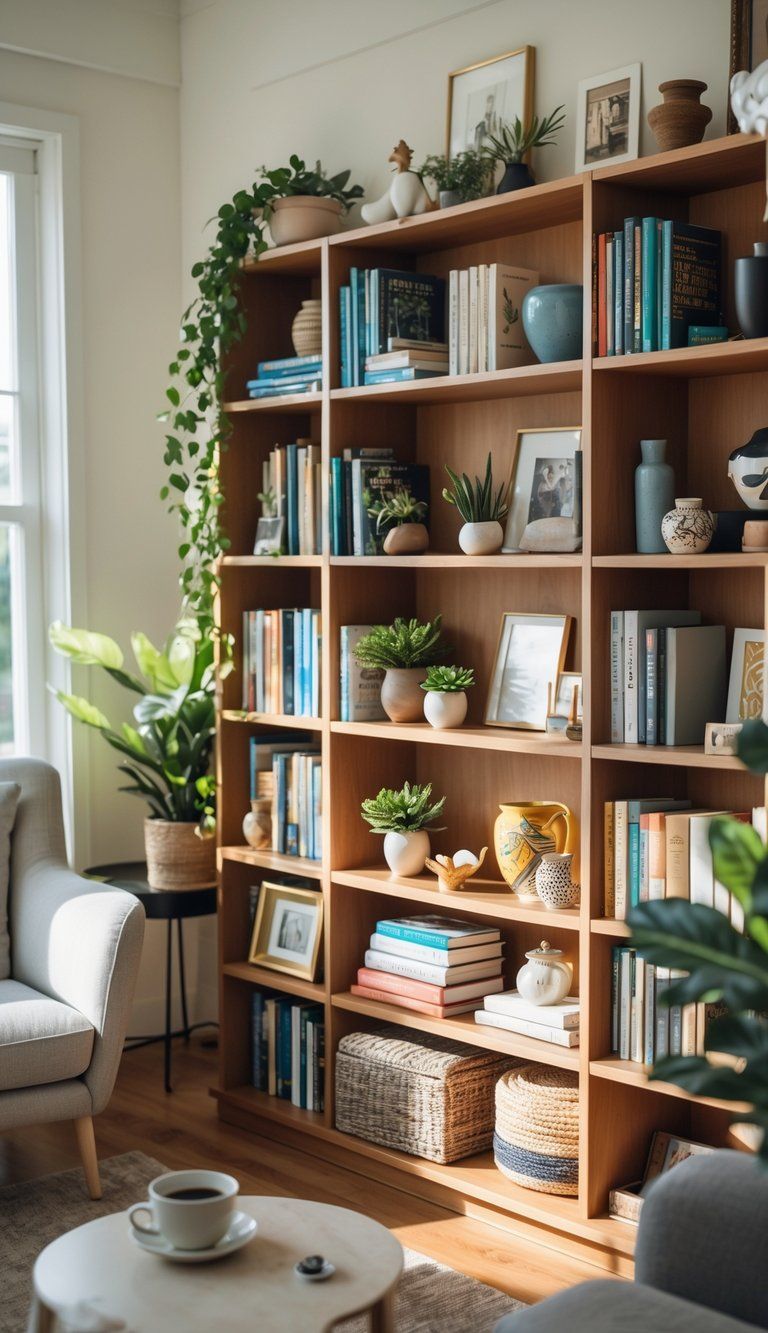
Before you buy anything, look around your place. Odds are, you’ve got plenty of stuff that can turn your shelves into something special—no shopping required.
Identifying Everyday Items For Shelf Decor
Start by looking for everyday things that can double as shelf décor. Kitchen bowls, teacups, or vintage bottles add a cool, unexpected touch. Plants—real or fake—bring life and a bit of color.
Small baskets or boxes can hide clutter and add texture. They work especially well under lower shelves.
Don’t forget about:
- Candlesticks or quirky candle holders
- Small mirrors that bounce light around
- Bookends you might have stashed away
- Clocks that look good and keep time
Even a neat stack of magazines or a matchbook collection can look decorative if you arrange it right.
Repurposing Decorative Items
Check for decorative pieces you aren’t really showing off. Maybe that vase on your kitchen counter would look way better on your bookshelf.
Try these ideas:
- Group similar things—three little vases look more interesting than one
- Move holiday décor to your shelves when it’s in season
- Swap out artwork—lean small frames against the back of a shelf
You can stand decorative plates up in holders. Art pieces are easy to rotate so your shelves always feel fresh.
Think about function, too. A pretty mug can hold pens or a little plant. Nice boxes can stash small stuff and add a splash of color.
Spotlighting Mementos And Sentimental Pieces
Bookshelves are the perfect place to show off things that matter to you. Family photos, souvenirs, and keepsakes deserve a spot in the spotlight.
Group related items together for mini-displays. A shell from vacation, a photo from the trip, and a small piece of art in similar colors make a nice little story.
Try this:
- Put special things at eye level
- Use books as risers for important pieces
- Spread mementos out instead of clustering them
Don’t hide your treasures away. That oddball figurine from your grandma? Let it shine.
The shelves that stick in your mind always have stories behind them. Your mementos make your shelves truly yours.
Choosing Your Color Palette And Visual Story
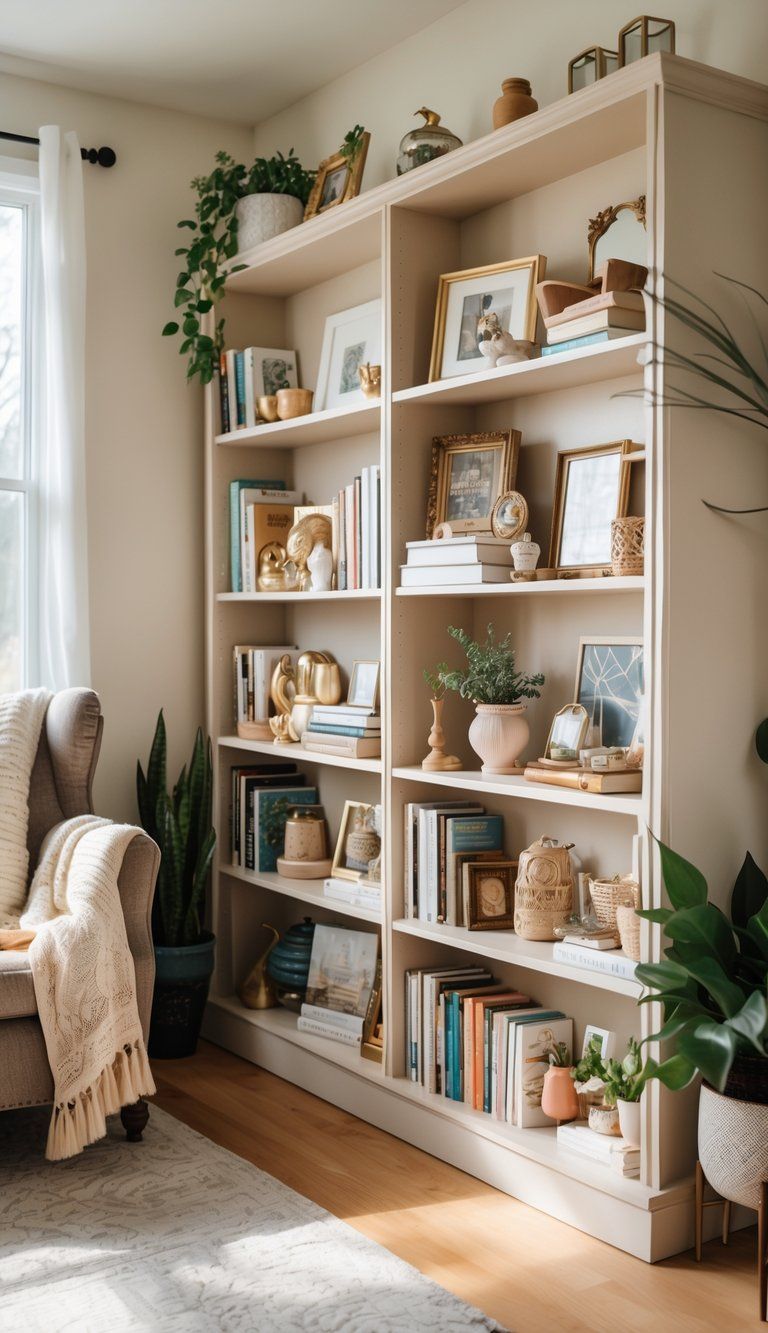
Your bookshelf isn’t just storage—it’s a canvas for your style. Picking a color story helps random things look like a curated collection.
Working With Your Room’s Color Scheme
Look at your room’s colors first. Your shelves should fit in, not fight with the space. Pull two or three colors from your walls or furniture to guide your shelf choices.
Try the 60-30-10 rule: make about 60% of your items one main color, 30% a secondary color, and 10% a bold accent. It keeps things balanced but not too matchy-matchy.
If you don’t have a ton of colorful stuff, group things by material—woods, metals, ceramics—for a natural palette.
Leave some white space between groups. Empty spots let your eyes rest and make styled items pop.
Highlighting Book Covers And Decorative Boxes
Book covers add color and texture all by themselves. Find books with spines that work with your palette and scatter them around.
Try these tricks:
- Stack books horizontally to make little platforms
- Group books with similar color spines
- Turn out special covers for display
Decorative boxes hide clutter and look sharp. Pick boxes in colors or textures that fit your theme.
Put bigger decorative boxes on lower shelves for weight. Smaller ones go up top. That keeps things grounded and practical.
Mix up textures—glossy, woven, matte—so your shelves don’t fall flat.
Strategic Arrangement And Layering Techniques
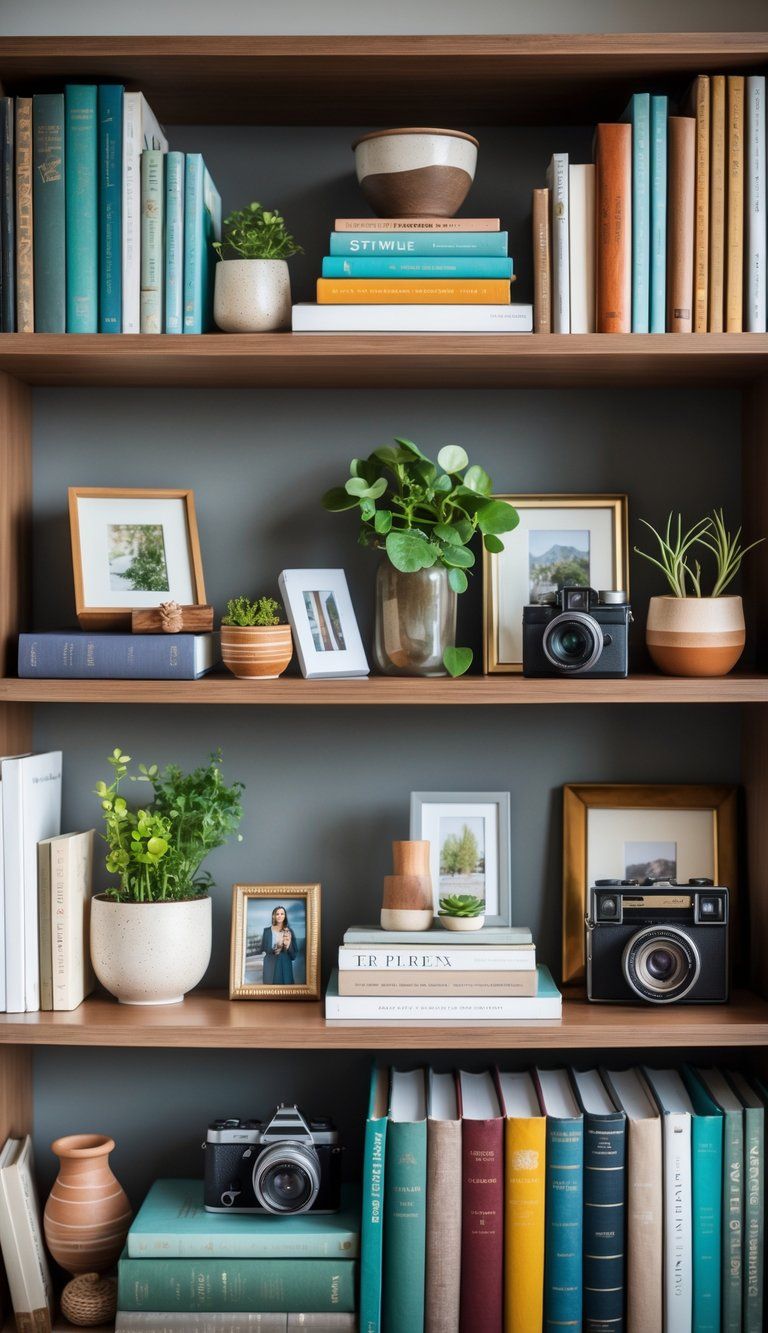
You can make your bookshelves look pro-level by focusing on how you arrange things and layering your items. With a few simple moves, you’ll turn clutter into a display—no shopping trip needed.
Using Horizontal Stacks And Vertical Rows
Books don’t have to stand up straight all the time. Mix in horizontal stacks for a change. Stack three or four books flat and top them with a decorative object. That creates a platform for smaller pieces.
For vertical rows, try:
- Grouping books by color for unity
- Arranging by height for a rhythmic look
- Tucking in small framed photos between book sections
Don’t feel like you need to fill every shelf. Leaving about 30% for decorative items keeps things balanced and less chaotic.
Balancing Negative Space And Breathing Room
Empty space matters. Give your items some room by leaving gaps between groups. This helps everything feel less crowded.
Adding Decorative Accents For Visual Intrigue
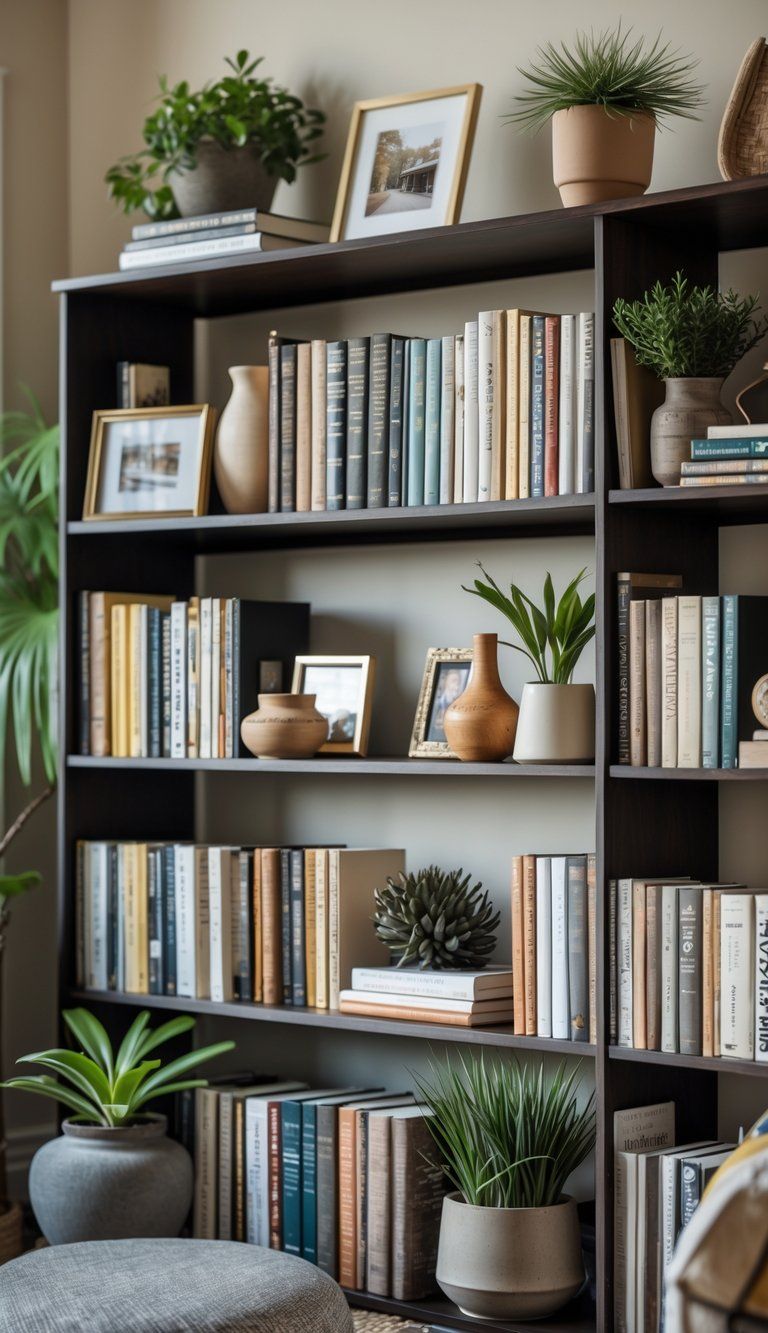
Decorative accents can make your shelves stand out and feel more “you.” These little touches add depth and interest—no shopping required.
Incorporating Metallic Accents
Metallics add a bit of glam. Hunt for brass candlesticks, silver frames, or copper bowls hiding in your cabinets.
Place metals where they catch the light. A brass bookend or a silver trinket box can anchor a shelf.
Mix up your metals for a collected look. Copper, brass, and silver can all work together if you spread them out.
Use small metallic trays or frames to break up book sections. Put them at different depths to create layers.
Showcasing Statement Pieces
Every shelf needs a few things that just grab your attention. Dig around for a cool vase, a quirky sculpture, or a favorite souvenir.
Put statement pieces at different heights to keep the eye moving. That makes the whole shelf feel more dynamic.
Try these placement ideas:
- Keep bigger items on lower shelves for balance
- Give odd-shaped pieces a little space
- Let statement items breathe—don’t crowd them
Swap in seasonal accents to keep things fresh. That ceramic pumpkin you packed away? It’s perfect for fall.
Mixing Picture Frames And Art
Photos and art make shelves feel personal. Grab frames in different sizes but similar styles to tie it all together.
Try this:
- Lean little frames against the back
- Put favorite photos at eye level
- Group similar colors or themes
- Mix up orientations—some horizontal, some vertical
Don’t stick to just framed photos. Postcards, your kid’s art, or small prints look great propped up or clipped to a mini easel.
Layer some frames up front, some in back. That adds depth and keeps things interesting.
Bringing Nature Indoors: Plants And Natural Elements
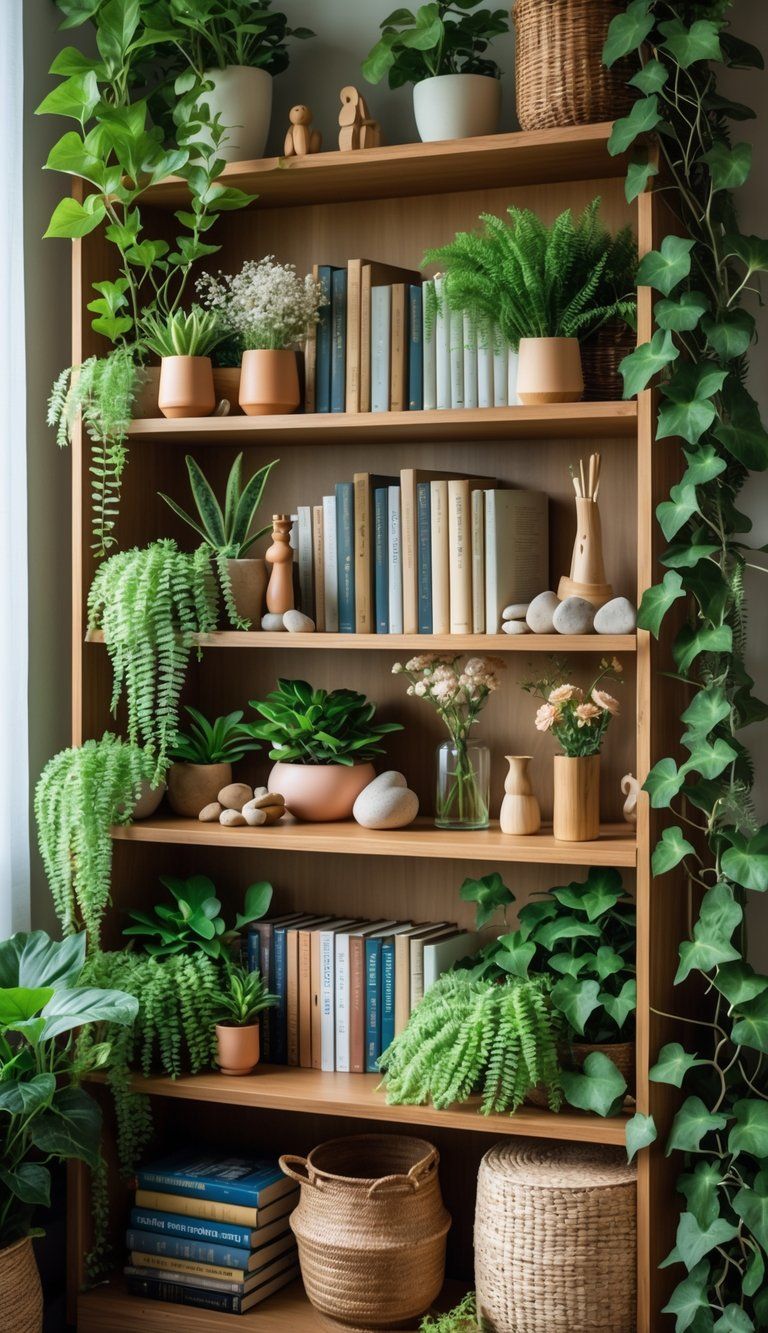
Nature just warms up a bookshelf, doesn’t it? Adding plants and natural touches brings calm, texture, and interest to your shelves—no extra spending required.
Styling With Houseplants
Small potted plants break up rows of books and add some much-needed height variation. You might want to try a trailing plant like pothos or ivy on an upper shelf—honestly, that waterfall effect looks great.
For lower shelves, I like to use small succulents. They barely need any care and their shapes are kind of fun.
If you don’t have a lot of plants, just rotate a single one between different spots every so often. It keeps things feeling fresh without much effort.
Air plants are a lifesaver if you’re short on soil or space. Tuck them between books, or pop them into any decorative container you’ve got lying around.
Books about gardening or nature look right at home near your plants. If your shelves get hardly any light, you’ll want to go for hardy options like snake plants or ZZ plants. They don’t mind dark corners at all.
Selecting Natural Elements For Warmth
Sometimes, the best shelf accents are free. Next time you’re out for a walk, keep an eye out for interesting branches, pinecones, or smooth stones. Group them in threes if you want a little extra visual punch.
Seashells from past trips? Toss them in a bowl or just line them up. If you have crystals or geodes, those catch the light in a really lovely way and instantly make your shelves look fancier.
Natural wood bits—like driftwood or bark—add a cozy, organic feel. You could use a wood slice as a mini platform for other items. Dried flowers or grasses from your yard? Just pop them in a small vase or jar and you’re set.
These little touches connect your space to the outdoors. Plus, they show off your personality through the things you’ve picked up over time.
Utilizing Functional And Stylish Storage
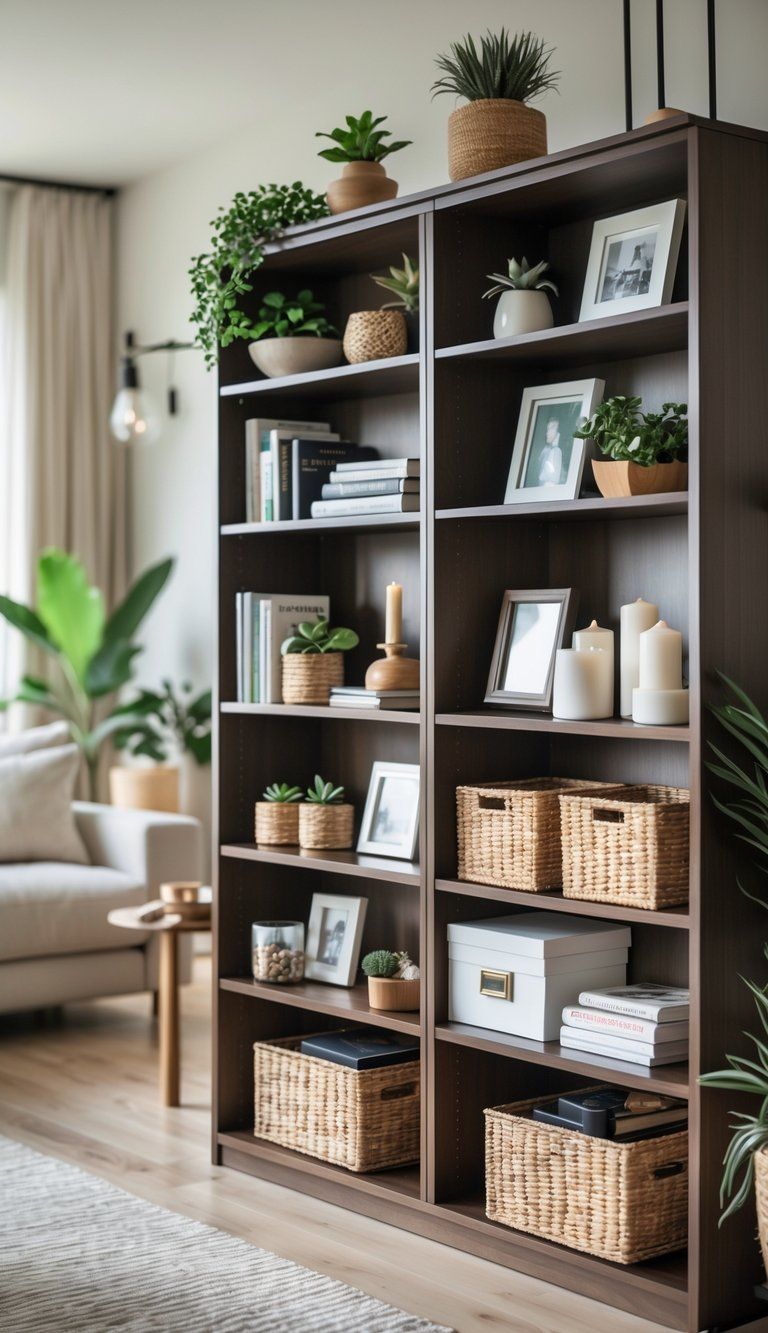
Smart storage can really change up your bookshelves. The right containers and a bit of rearranging can make your shelves look good and stay tidy.
Decorative Containers For Organization
Baskets hide clutter and add texture, which is always a win. Don’t forget to check around your place for decorative boxes, ceramic bowls, or jars you’re not using—they’re perfect for corralling little things.
Repurpose what you have:
- Glass jars for small office stuff
- Vintage teacups for paperclips or jewelry
- Decorative boxes for remotes or chargers
Try to group similar things in matching containers. It just looks more pulled together. I usually put baskets on lower shelves for bulkier things like blankets or toys. They’re still easy to grab but not in your face.
Mix up the heights of your containers. Tall woven baskets next to shorter stacks of books? That’s how you keep things interesting.
Highlighting Coffee Table Books
Coffee table books can totally work on shelves, not just the coffee table. Their covers and size make them stand out.
A few ways to display them:
- Stand them up to act as bookends
- Stack a couple horizontally as a base for small decor
- Arrange by color if you want a big visual impact
I like taking off the dust jackets to reveal those simple covers underneath. It gives the shelf a cleaner, more unified look.
Put your best-looking books at eye level so people actually notice them. If you find a gorgeous page, open the book and prop it up like art. Switch it out whenever you feel like it.
Practical Styling Tips For Built-In Bookshelves And Bookcases
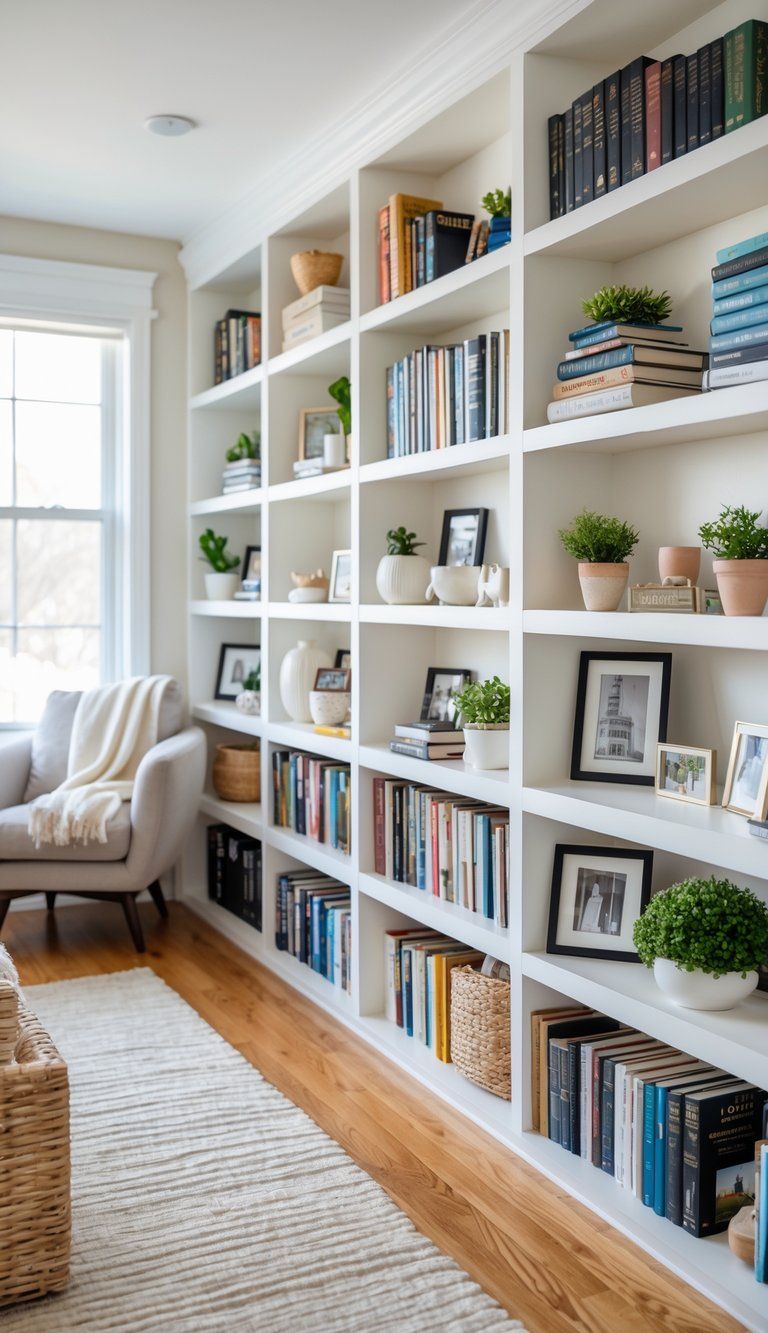
Built-in bookshelves can really change the feel of a room. If you style them with intention, you’ll get a setup that feels organized but still personal.
Curating Shelf Decor For Built-In Spaces
Start by clearing off everything. It’s easier to see what you’re working with when you have a blank slate. Before you put stuff back, group similar items together.
Mix up the heights and shapes of what you display. Place tall pieces next to shorter ones, and mix up rectangular books with round vases or spheres.
Try using the “rule of three.” Odd numbers, like three items of different heights, usually look more interesting than even groupings.
A few ways to arrange books:
- Stand them up vertically (the classic)
- Stack them horizontally to make little platforms
- Sort by color for visual pop
- Flip spines inward for a neutral look
Leave a bit of empty space between groups. Not every spot needs something crammed in—breathing room actually helps your favorite pieces stand out.
Creating A Focal Point
Every good bookcase needs a focal point that grabs attention. Pick one or two shelves to show off your most interesting stuff.
Try these ideas:
- Center a big piece of art or a mirror
- Install a picture light above your favorite display
- Add a bright splash of color against neutrals
- Display one oversized object
Keep your focal point at eye level or just above—it’s where people naturally look first.
Frame this area with simpler items that don’t compete for attention. Sometimes, adding a plant nearby softens the lines and brings in a little life.
Switch up your focal point with the seasons. A quick change here can make the whole room feel new without much effort.
Avoiding Common Styling Missteps
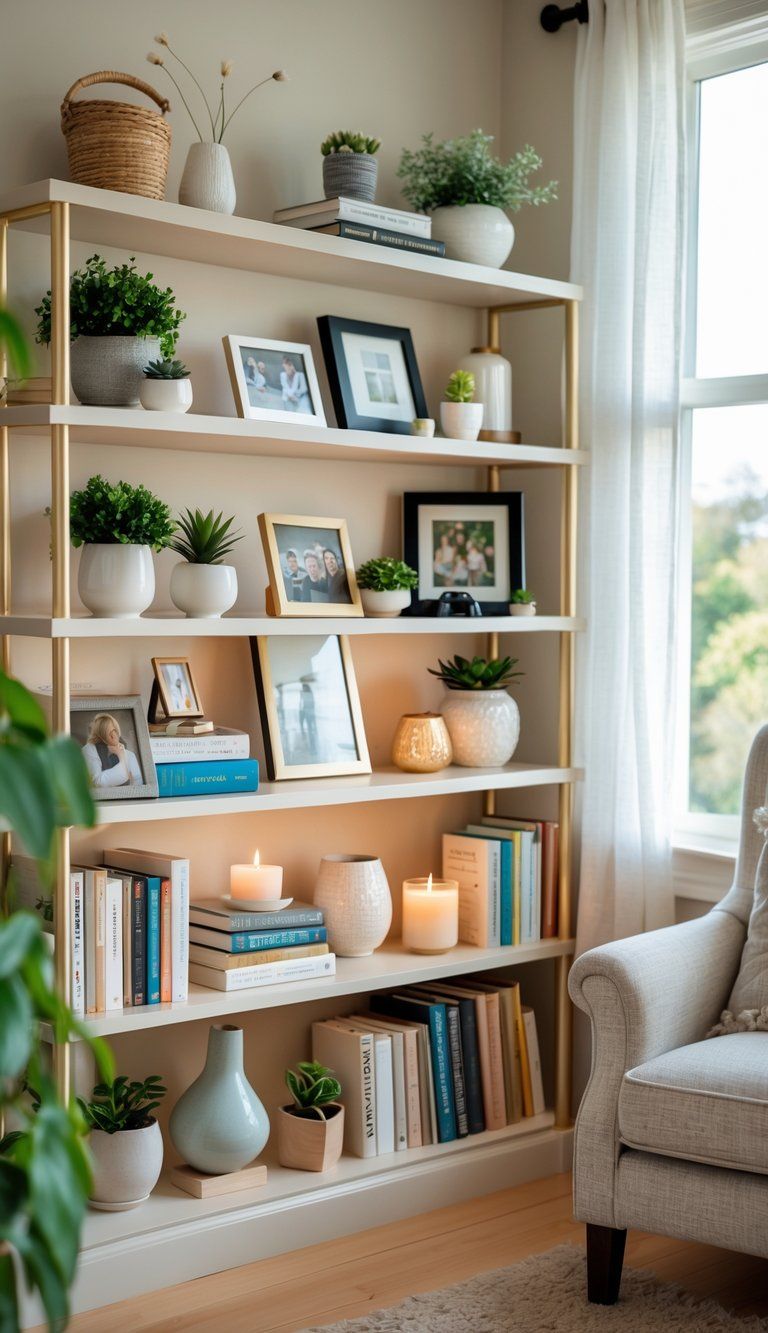
Styling bookshelves isn’t always as easy as it seems. Some mistakes can make your shelves look messy or just kind of blah. If you know what to avoid, you can pull together a polished look using what you already have.
Preventing A Cluttered Shelf
Using too many materials on one shelf leads to visual chaos. Stick with three or four types of materials (like wood, glass, and metal) for a more harmonious vibe.
Don’t line up everything along the front edge. Instead, push some objects back and pull others forward to add depth. This makes the display feel more dynamic.
Leave some empty space. Those blank spots let your eyes rest and actually highlight your favorite pieces. Think of them as part of the design, not wasted space.
Try arranging things in triangles or diamonds instead of straight lines. For instance, put one item in the middle up top, two on the next shelf, then one below. It’s a subtle trick, but it really works.
Refreshing Your Look Over Time
Go ahead and set a reminder to update your shelves with the changing seasons. Swapping out a few decorative pieces keeps your display feeling fresh—no need for a total overhaul.
Before you buy anything new, take a walk around your own home. Maybe that ceramic vase in your dining room or the small plant from your office would look just right on your bookshelf.
Snap a few photos of your current setup before you start moving things around. That way, you can remember what worked well—and hopefully avoid making the same mistakes twice.
Rotate your book collection now and then. Try displaying different titles by color, size, or even subject to bring in some new visual interest without spending a dime.
Give the “remove and replace” trick a shot. Clear everything off one shelf, then only put back what really deserves a spot there. Sometimes less really is more, isn’t it?

